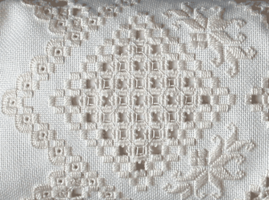



Hardanger embroidery or『Hardangersøm』is a form of embroidery traditionally worked with white thread on white even-weave linen or cloth, using counted thread and drawn thread work techniques. It is sometimes called whitework embroidery.
Hardanger embroidery gets its name from the district of Hardanger in western Norway, where it was known simply as hvitsøm (whitework). Traditionally, this geometric embroidery and cutwork technique was worked in white linen thread on handwoven white linen fabric and used only as trim on garments.
The exact origins of Hardanger embroidery are not known but it is thought to have its beginnings in ancient Persia and Asia. During the Renaissance, this early form of embroidery spread to Italy where it evolved into Italian Reticella and Venetian lacework. By 1700, variations of this type of embroidery had spread to northern Europe where it developed further into Danish and Dutch Hedebo, Scottish Ayrshire embroidery as well as Norwegian Drawn Work, as it was then called.[1]
In the period between 1650-1850 Hardangersom (meaning: work from Hardanger area) flourished in Norway. Flax was grown, carded, spun and woven into white fabric and thread which was used to make and decorate traditional Norwegian costume items called bunads (national costumes) as well as other items of clothing and household linens such as mats, curtains and bedspreads.
Historically, Hardanger employed linen evenweave fabric of 36 count or higher. However, modern Hardanger fabric is an evenweave cotton material woven with pairs of threads, typically 22 pairs per linear inch in both directions, referred to as '22-count'. The weave gives a squared appearance to the fabric (similar to Aida cloth), with distinct holes, making it easy to count and work on.
Traditional Hardanger embroidery is worked with linen thread colour that matches the fabric, usually white or cream. Using self-coloured thread enhances both the sculptural nature of the stitches and the details in the intricate filling stitches.
Modern Hardanger can employ a large variety of threads. Two weights of Pearl (perlé) cotton are generally used. On normal 22-count Hardanger fabric this is usually Pearl cotton #5, a heavier weight used for satin stitch Kloster blocks and motifs, and Pearl cotton #8, a thinner thread used for more delicate filling stitches and other surface details. On finer, higher count fabrics the combination of #8 and #12 threads is often more suitable. Many contemporary designs, however, do make use of coloured, variegated and overdyed threads to great effect.
Hardanger embroidery uses satin stitch blocks known as Kloster blocks, consisting of 5 parallel satin stitches, worked over a group of 4 x 4 ground threads. These blocks enclose areas of fabric where a number of warp and weft threads are cut and withdrawn, leaving a network of loose threads and large holes within the shape defined by the Kloster blocks. Various decorative filling stitches are then worked over the remaining loose threads and holes to create a lacy effect.
Some of the stitches and special techniques used are:
The traditional style of Hardanger work is very geometrical in form and based on several basic shapes such as squares, rectangles, triangles, diamonds, hearts, zig-zags and crosses. The combination and placement of these elements allow an unlimited number of beautiful patterns of all sizes to be created.
A wide range of patterns are available today for the modern needleworker to try, in both traditional and contemporary styles. Hardanger is still used to decorate cushions, table linen and other household items as well as items for display on a wall. Several modern needlework designers have incorporated elements of Hardanger cut work into their embroidery designs and samplers, often combining them with other needlework techniques, stitches, speciality threads and other embellishments to great effect.
Some Lutheran pastors of Norwegian descent in the United States have had stoles embroidered with Hardanger work made for their use. While altar paraments in Hardanger work have been traditional in Norwegian churches for a long time, their use in American Lutheran churches is becoming more common as an alternative to the more traditional machine-embroidered damask paraments. Even the traditional alternating cross and chalice motif of Norwegian Hardanger work is now found in American Lutheran churches.
|
| ||
|---|---|---|
| Styles |
| |
| Stitches |
| |
| Tools and materials |
| |
| Regional |
| |
| Embroideries |
| |
| Designers |
| |
| Organizations |
| |
| Related |
| |